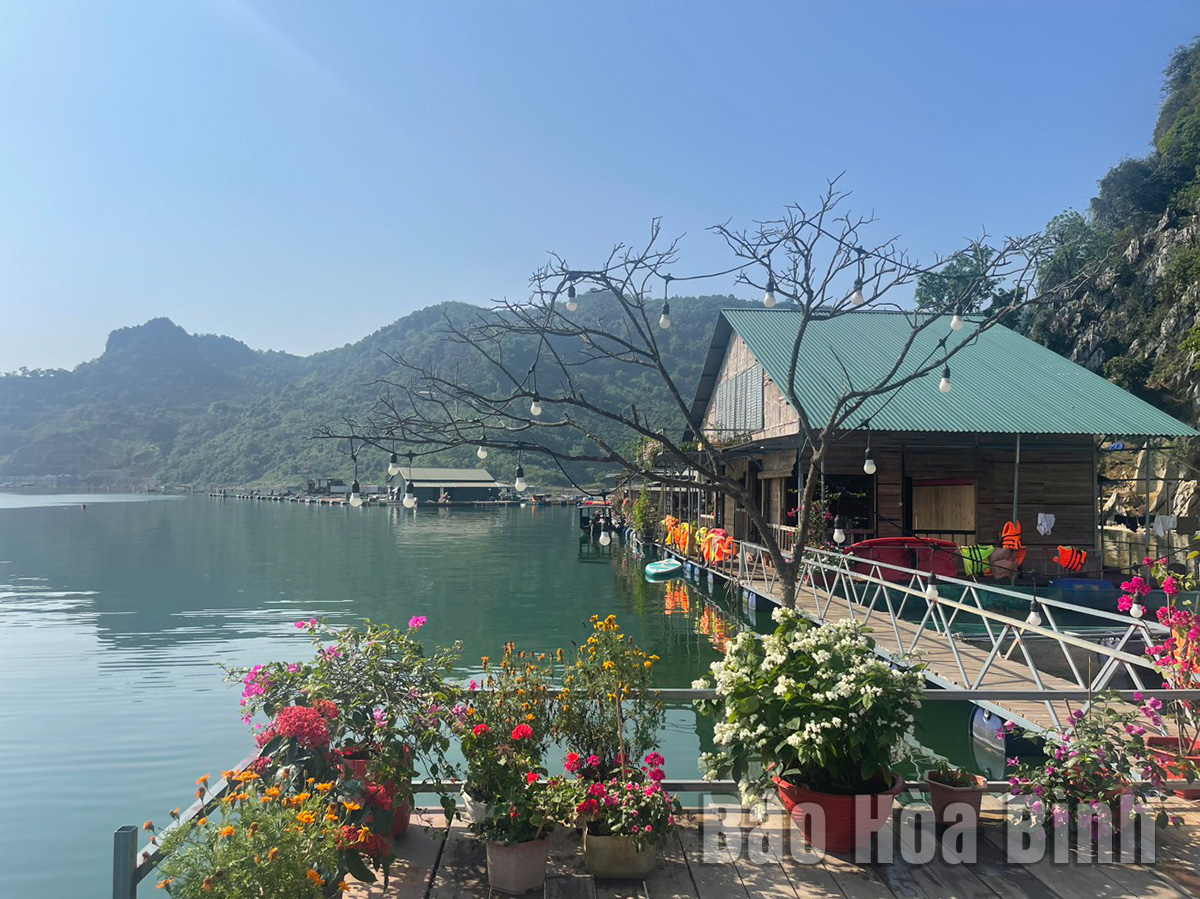
(HBO) - Hoa Binh reservoir in the northern province of Hoa Binh has a capacity of more than 9 billion m3 and rich aquatic resources. The area is considered a precious treasure of aquatic life, and it is likened to Ha Long Bay on land, attracting a large number of tourists
In 2016, the Prime Minister approved a master plan to develop the reservoir into a national tourism area until 2030. Taking advantages of the water surface and majestic natural landscape, many local households have developed fish cage farming associated with tourism development, bringing high economic efficiency.
Homestay of Nguyen Van Binh’s family in Thai Binh ward of Hoa Binh city.
Nguyen Van Binh in Thai Binh ward of Hoa Binh city has been engaged in fishing and cage farming for more than two decades on the lake. Currently, his family has seven cages for raising fish, mainly salmon, perch and carp. However, in recent years, when the market has begun to saturate and especially due to impacts of the COVID-19 epidemic in 2021 – 2022, affecting fish prices, Binh decided to turn his fish raft into a floating homestay to serve tourists. On average, his homestay welcomes some 400 visitors a month in summer, helping to generate a stable source of income.
In recent years, many households in the area have developed the model of fish cage farming in combination with eco-tourism development. Currently, nearly 20 households in Voi and Thau residential areas and some hamlets in the lake-bed area of Thung Nai (Cao Phong), Vay Nua, Tien Phong (Da Bac) communes have registered to operate this type of business.
There are now nearly 5,000 fish cages in the Hoa Binh hydropower reservoir, with an average annual output of nearly 10,000 tonnes. Fish cage farming associated with tourism development is currently the direction many households are aiming to awaken the potential and strengths of the Hoa Binh lake.
According to Nguyen Huy Nhuan, Director of the provincial Department of Agriculture and Rural Development, in order to both sustainably develop the fishery industry and tourism in the area, the department has directed the Fisheries Sub-Department to guide fish cage households and communes continue to develop effectively breeding of aquatic species with economic values associated with ecological environment protection. In particular, households are asked to focus on specialty fish in the lake, and apply VietGAP farming process, science and technology to aquaculture production in order to increase added valuesand reduce costs.
The province has also encouraged and supported the development of aquaculture in association with tourism, educational activities, eco-tourism and sightseeing tours./.
Located just a 20-minute drive from Hoa Binh City, Ora Hill Farmstay & Glamping Hoa Binh is a captivating new destination nestled in Mo hamlet, Bình Thanh commune, Cao Phong district. Combining farming with leisure, this tranquil retreat is perfect for those seeking balance, joy, and an immersive experience in the expansive beauty of nature.
Muong Bi - Tan Lac is renowned as one of the four famous Muong regions in Hoa Binh province. Blessed by nature with a favourable climate and stunning landscapes, Tan Lac holds great advantages for tourism development. The local tourism industry has made remarkable strides in recent times thanks to the attention and support from the local authorities and sectors.
With its strategic location, well-developed transport network, and diverse soil and climatic conditions, Hoa Binh is emerging as a must-visit destination in Vietnam's northwestern tourism corridor. The province boasts numerous attractions, including the Kim Boi hot springs (Kim Boi district), the Dau Rong cave complex (Cao Phong), the Mai Chau valley (Mai Chau), and the iconic Hoa Binh hydropower plant.
The northern mountainous province of Hoa Binh has been listed among the 71 most beautiful places to visit worldwide by the prestigious US travel magazine Condé Nast Traveller.
Hoa Binh province’s rich natural and cultural resources position it as a prime location for developing community-based tourism (CBT). In recent years, support from central and provincial policies, as well as assistance from non-governmental organisations, have encouraged local ethnic minority and mountainous communities to actively engage in the sector.



